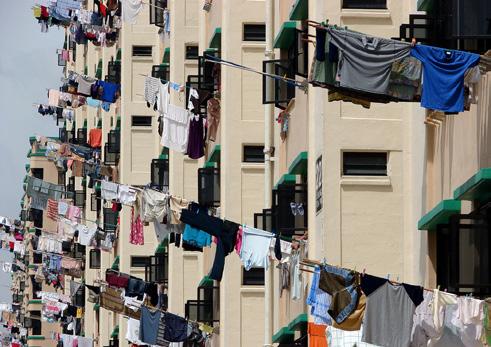
3 minute read
research themes
The idea of urban vitality underpins student’s investigations of street life and is examined through the lens of a chosen sub-theme in small interdisciplinary and intercultural teams. This course draws on Adams and Tiesdell’s (2007) incremental description of vitality as, at one level, “simply being alive and able to survive”, and then, “the capacity not just to survive but to grow and develop”, and ultimately, “that mysterious, immaterial power that variously generates life, enables survival, produces growth, and gives health, energy and vigour.” In the context of the city, urban vitality can then be linked to the fostering of resilient, inclusive, convivial places that are a result of social structures, spatial arrangements, economic forces and governance . Exploring these facets across two cities, students examine diversities and commonalities in the emergence of urban vitality. Adams, D., & Tiesdell, S. (2007). Introduction to the special issue: The vital city. The Town Planning Review, 78(6), 671-679.
THEME 3 THE FACE OF THE CITY: FACADES
Advertisement
THEME 4 THE POROUS CITY: PRIVATE PUBLIC BUILDING THRESHOLDS
THEME 5 THE POROUS CITY: PRIVATE PUBLIC FENCE THRESHOLDS
Private public threshold
Vital streets encourage a level of ‘adaptability’ by their users. Users have an innate knowledge of their surrounds and are often the most effective 'designers' of the spaces they inhabit. Facades are an overt expression of this; their planned and unplanned manifestations often a strong contributor to the visual identity of a place. How can the 'base' components of a facade allow for adaptability by users?
Vital streets support interactions across the thresholds of private, interior space and public, exterior space. How can this boundary be re imagined to encourage a stronger relationship (be it direct or indirect) between internal and external users and activities.
DELIVERABLES x6 A5 observation cards for each city
OBSERVATION 1
OBSERVATION 2
OBSERVATION 3
Visual Card Data Card
Visual Card Data Card
Visual Card Data Card
Essential reading
The Slow City
1 Till, Jeremy. 'Architecture and Contingency.' 120. ISSN: 1755-068. www.field-journal.org. vol.1 (1)
2 Inara Nevskaya. 'Soft Dimensions' Volume Magazine n.33
3 'Edges and Paths' (pp 49-66) in: Lynch, Kevin. The Image of the City. Cambridge MA: MIT Press 1960
Encouraging longer stays
Essential reading
The Adaptable City


Essential reading
Fostering agency and identity
SCALE scales shown refer to drawing in sketchbook. final output scale (on A5 cards) may be smaller/larger.
1 Gehl, Jan; Johansen Kaefer, Lotte; Reigstad, Solveig, ‘Close encounters with buildings’. Urban Design International (2006) 11. Palgrave Macmillan Ltd. 2006
2 Paramita Atmodiwirjo, Yandi Andri Yatmo and Verarisa Anastasia Ujung. 'Outside Interior: Traversed boundaries in a Jakarta urban neighbourhood (pp 78-89) In: Atiwill, Susie. Urban+Interior. IDEA Journal ISSN 1445/5412. 2015
The Porous City
1 Maltby,Elliott+ Nandan, Gita. The Field Guide to Fences. Jan 2017 https://nextcity.org/features/view/nyc-field-guide-fences-public-space
SCALE
2 "Control architectures, Jittery enclaves, Passage point urbanism' (pp99-109) Graham, Stephen. Cities Under Seige. Verso. New York. 2011
Increasing threshold interactions
scales shown refer to drawing in sketchbook. final output scale (on A5 cards) may be smaller/larger. ensure clarity
The Inclusive City
3 Sperber, Elliot. 'The Concept of the Wall.' Roar Magaine. Issue 4. Nov 2017. https://roarmag.org/magazine/the-concept-of-the-wall/
OBSERVATION O1: THRESHOLD POROSITY
Focus points
· Modifications to original facade by users
Vital streets allow people to linger. Longer stays can contribute to streets that are a ‘hive’ of diverse activity. How can streets encourage a slowing down that broadens their purpose beyond circulation?
Field of view: facade full building height 2-3 buildings wide
Repeat in: Locations x3 (2-3 ‘units’ each)
Time frames x1
Show Layers: Planned
Focus points
· Proportion of porosity in GF façade
· ‘Level’ of porosity in each opening
· Drivers of porosity
· Internal building function (GF)

Vital streets allow adaptability by their users. Modifications made to facades often express the cultural identities of a place. How can the spatial componentry of facades foster these appropriations?
Field of view: int/ext thresholds windows or doors ground floor only commercial OR residential in: Locations x3 (2-3 ‘units’/each)
OBSERVATION 1: FENCE POROSITY
Focus points
· Level of porosity
· Fence + human body
· Fence + building function
Vital streets prompt interactions between diverse users and activities. How can the urban-interior boundary be re-imagined to increase the frequency of such interactions?

Field of view: several fences in a row
Repeat in:
Output
Activating edges peripheries of space. In increasingly demarcation of space or blocking of










